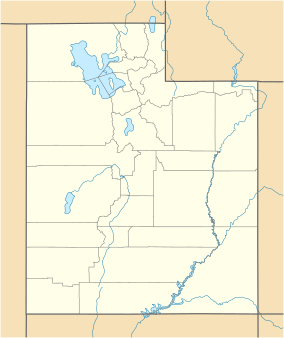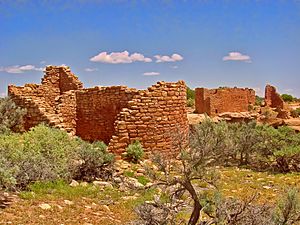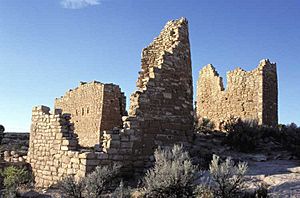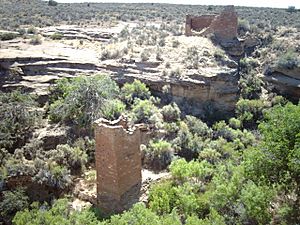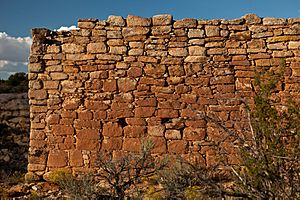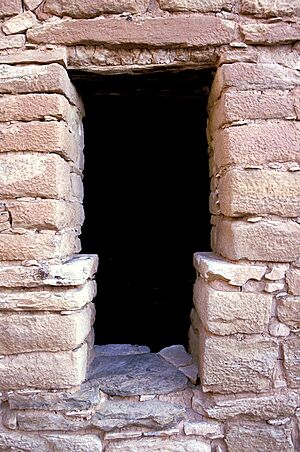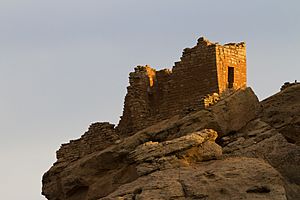Hovenweep National Monument facts for kids
Quick facts for kids Hovenweep National Monument |
|
|---|---|
|
IUCN Category III (Natural Monument)
|
|
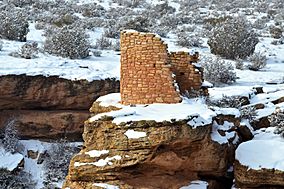
Horseshoe Tower in the snow
|
|
| Location | Montezuma County, Colorado & San Juan County, Utah, USA |
| Nearest city | Bluff, Utah, Blanding, Utah |
| Area | 784 acres (317 ha) |
| Created | March 2, 1923 |
| Visitors | 39,970 (in 2017) |
| Governing body | U.S. National Park Service |
| Website | Hovenweep National Monument |
Hovenweep National Monument is a special place in southwestern Colorado and southeastern Utah. It's found between the towns of Cortez, Colorado and Blanding, Utah, on a flat area called the Cajon Mesa. Small streams flow through deep canyons here, eventually reaching the San Juan River.
This monument is famous for its six groups of ancient villages built by the Ancestral Puebloans. But people lived here much earlier too! There's proof that hunter-gatherers were here from about 8,000 BC until 200 AD. After that, different groups of early Pueblo people settled down and stayed until the 1300s.
Hovenweep became a National Monument in 1923. The National Park Service takes care of it. In 2014, it was even named an International Dark Sky Park. This means it's a great place to see the stars because there's very little light pollution.
Contents
A Look Back: Hovenweep's History
Early People of Hovenweep
Evidence shows that very old groups, like Paleo-Indians and people from the Archaic period, lived here. Over time, these hunter-gatherers slowly changed their way of life to become the Ancestral Puebloans.
Hunters and Gatherers (8,000 BC to 50 AD)
For thousands of years, early hunters and gatherers lived in this tough landscape. It had deep canyons, few animals, and not much water. This made life hard and meant they had to hunt in small groups. They were very good at finding food. They ate wild plants, nuts, seeds, and fruits. Scientists have found tools from these early people. Some tools are from Paleo-Indians who camped here as early as 8,000 BC. Others are from Archaic-Early Basketmaker people from about 6,000 BC.
Basketmakers (50 AD to 750 AD)
Around 2,000 years ago, people in the Four Corners area learned about maize (corn) and basketry. This came from trading with groups further south. Growing their own food meant they didn't have to move around as much. Small groups started farming corn and squash. They still hunted and gathered wild plants too.
They were called "Basketmakers" because they were amazing at making baskets. They used baskets to store food, to heat water (by covering them with pitch), and to toast seeds. They also made bags, sandals, and belts from yucca plants. Sometimes, they lived in dry caves and dug pits lined with stones to store food. These Basketmakers were the ancestors of the Pueblo people who later built the Hovenweep villages.
Later, around 500 AD, they started making pottery. This meant they didn't need as many baskets for cooking and storage. They also added beans to their diet. The invention of bows and arrows made hunting easier. They used turkey feathers to make warm blankets. Small groups built "pit houses" which were partly underground. These houses show signs of early ceremonies.
Pueblo Builders (750 AD to 1350 AD)
Over time, the people learned to build with stone. Their buildings had windows facing south to catch the sun. They started building towers near special round rooms called kivas. These towers might have been used as lookouts. Pottery became more varied, with different shapes for cooking, eating, and drinking. They even made white pottery with black designs from plant pigments. They also learned how to manage water, building reservoirs and dams to save water.
Around 900 AD, more people started living at Hovenweep. Like other Pueblo people, they moved their villages from flat mesa tops to the heads of canyons. This was usually near springs or other water sources. Most of the large stone buildings we see today were built between 1230 and 1275. At that time, about 2,500 people lived here. The buildings and pottery at Hovenweep are very similar to those found at Mesa Verde.
The Hovenweep people were skilled builders. They didn't always make flat foundations. Instead, they adapted their designs to the uneven rock surfaces. These stone buildings were so impressive that early explorers called them "castles." Some famous structures include Hovenweep Castle, Hovenweep House, Square Tower, and Twin Towers. These buildings were part of larger communities built around the canyon springs.
Scientists found two ancient paintings from Hovenweep. These paintings, called murals, tell us a lot about the daily life of the ancient people. They are now kept at the Anasazi Heritage Center.
The Six Pueblo Villages
Hovenweep National Monument protects six main groups of ancient Pueblo buildings:
- Cajon Group: This village was built at the head of Allen Canyon. It had many rooms and a tower on a large rock. About 80-100 people might have lived here. There are also signs of terraced farming below the canyon rim.
- Cutthroat Castle Group: This group is in a side canyon. Cutthroat Castle is the largest ruin here. It's special because it doesn't have a spring nearby, and many buildings are below the canyon rim.
- Goodman Point Group: This is the biggest village and is located furthest east. It has many clusters of buildings, some partly underground. It was most crowded between 1150 and 1300.
- Holly Group: Found at the head of Keeley Canyon. This site is known for a rock art panel that might have been used to mark the summer solstice. The main buildings here are Curved Wall House, Great House, Holly Tower, Isolated Boulder House, and Tilted Tower.
- Hackberry and Horseshoe Group: Hackberry was a medium-sized village in Bridge Canyon. About 250 to 350 people lived there. About 500 yards away, the Horseshoe group has four buildings shaped like a "U." Horseshoe Ruin had a dam to create a water reservoir. The Horseshoe House is a D-shaped building that might have been used for ceremonies. The buildings here were made with "precisely fit" stones and a special mortar.
- Square Tower Group: This is the largest collection of buildings at Hovenweep, with up to 500 people living there. It's in Little Ruin Canyon. The towers here come in many shapes: D-shapes, squares, ovals, and circles. They were used for different things like working areas, storage, homes, and kivas for rituals. Many towers have small windows or slots. The slots and doors of Hovenweep Castle, in this group, seem to work like a solar calendar. Light shines through openings at sunset during the summer solstice, winter solstice, and the spring and fall equinox. This light falls in a special pattern on the inside walls.
Life and Resources
Farming and Food
The Hovenweep people were skilled farmers. They grew crops like corn, amaranth, beans, squash, and cotton in terraced fields. They used dams to direct water to their crops. They also gathered wild plants like beeweed, cattail, sedges, ground cherry, milkweed, and wolf berry.
Scientists have found that the Puebloans also ate sagebrush flowers, seeds, and leaves. In small amounts, sagebrush gave them iron and Vitamin C. In larger amounts, it helped kill tiny parasites in their bodies.
Natural Materials
The land around Hovenweep provided many materials for daily life. Trees were used for building and fires. They sealed baskets with sap from piñon trees. Clothing and sandals were made from juniper bark. Tools like hunting points, scrapers, and knives were made from quartz stones.
Why Did They Leave?
Scientists think that changes in the climate and a growing population put a lot of pressure on these communities. The Hovenweep people left their villages in the late 1200s. This might have been because of a long drought that lasted 23 years. Many people across the entire Four Corners region were leaving their smaller communities around this time. By 1350, the area was likely almost empty.
Archaeological evidence suggests that people from this region moved south. They likely went to live with the Hopi people in Arizona and other Pueblo people along the Rio Grande in New Mexico.
How Hovenweep Was Discovered
In 1854, a man named William D. Huntington found the ruins that are now Hovenweep National Monument. He was on a trip for Brigham Young. The Ute and Navajo guides already knew about the ruins. They thought the ruins were haunted and told Huntington to stay away.
The name Hovenweep means "deserted valley" in the Ute language. This name was chosen by photographers William Henry Jackson and William Henry Holmes in 1878. It's a good name for the empty canyons and flat areas, and for the ruins of these ancient communities.
In 1903, T. Mitchell Pruden surveyed the ruins in the Four Corners states. He was worried about people damaging the ancient sites. He reported that many mounds at Hovenweep had been dug up by cattlemen, ranchers, picnickers, and collectors. They took pottery and broke many things.
Later, in 1917–18, a scientist named J. Walter Fewkes from the Smithsonian Institution wrote about the ruins. He suggested that the structures should be protected. Not much archaeological digging happened at the sites until the 1970s.
Hovenweep National Monument Today
President Warren G. Harding declared Hovenweep a National Monument on March 2, 1923. The National Park Service manages it. On October 15, 1966, Hovenweep National Monument was added to the National Register of Historic Places.
When you visit Hovenweep National Monument, you can find:
- A Visitor Center at the Square Tower Group.
- A campsite with 31 spots at the Square Tower Group.
- Hiking trails to explore the ruins.
- Parking, picnic areas, and restrooms.
See also
 In Spanish: Monumento nacional Hovenweep para niños
In Spanish: Monumento nacional Hovenweep para niños


